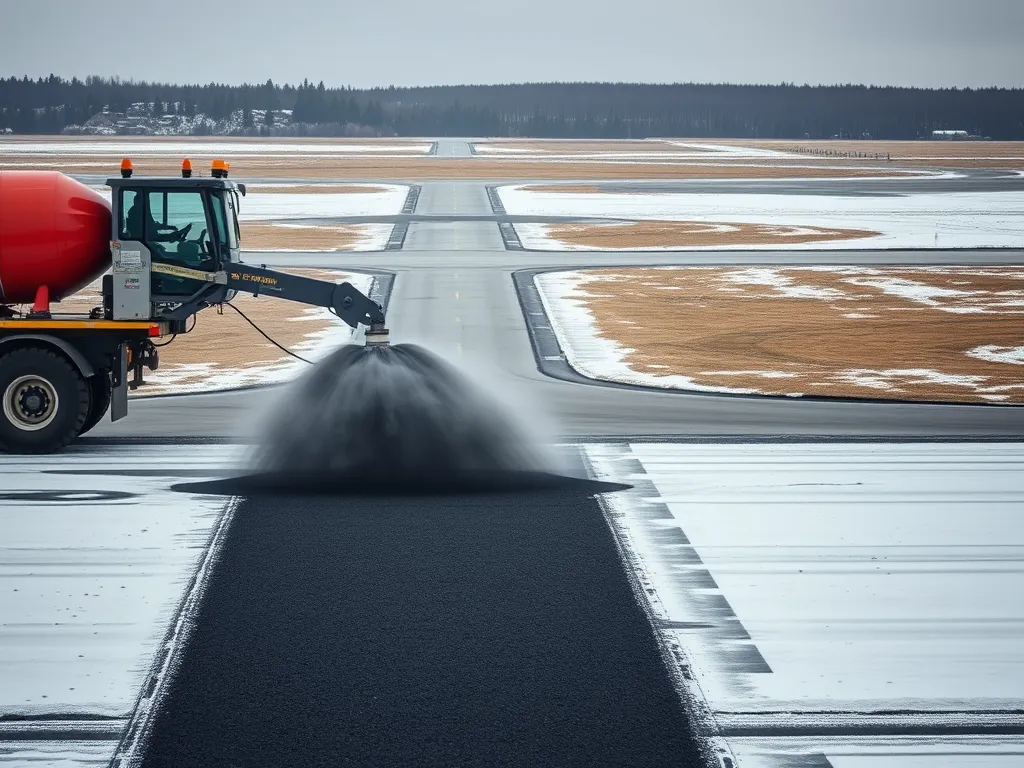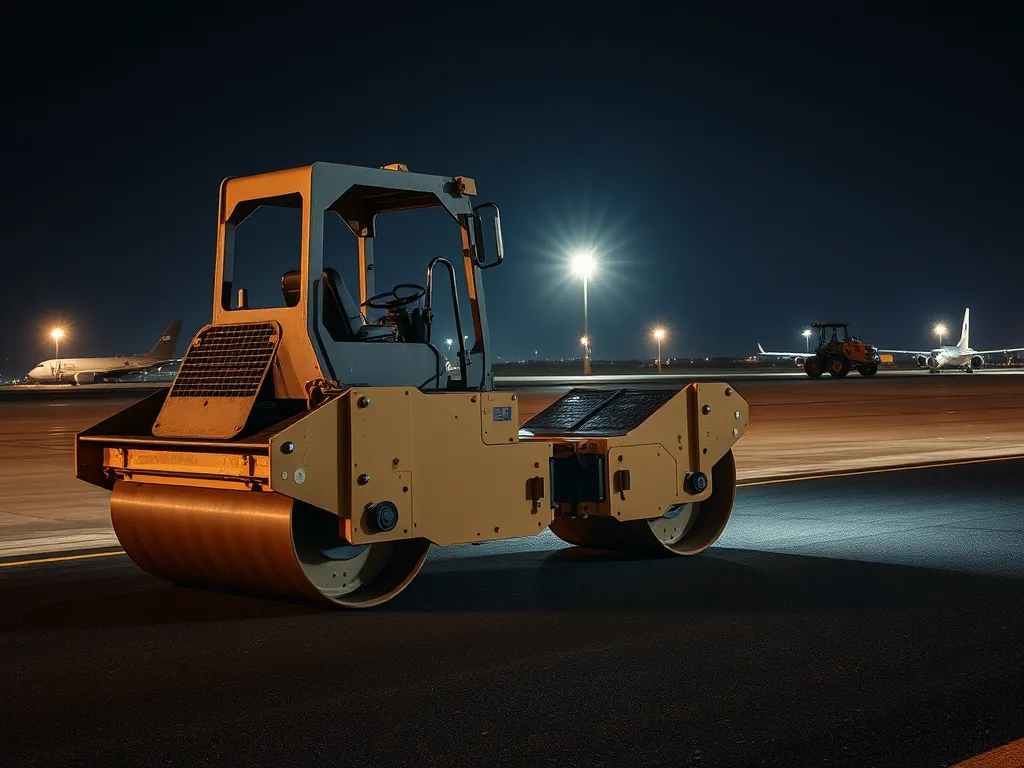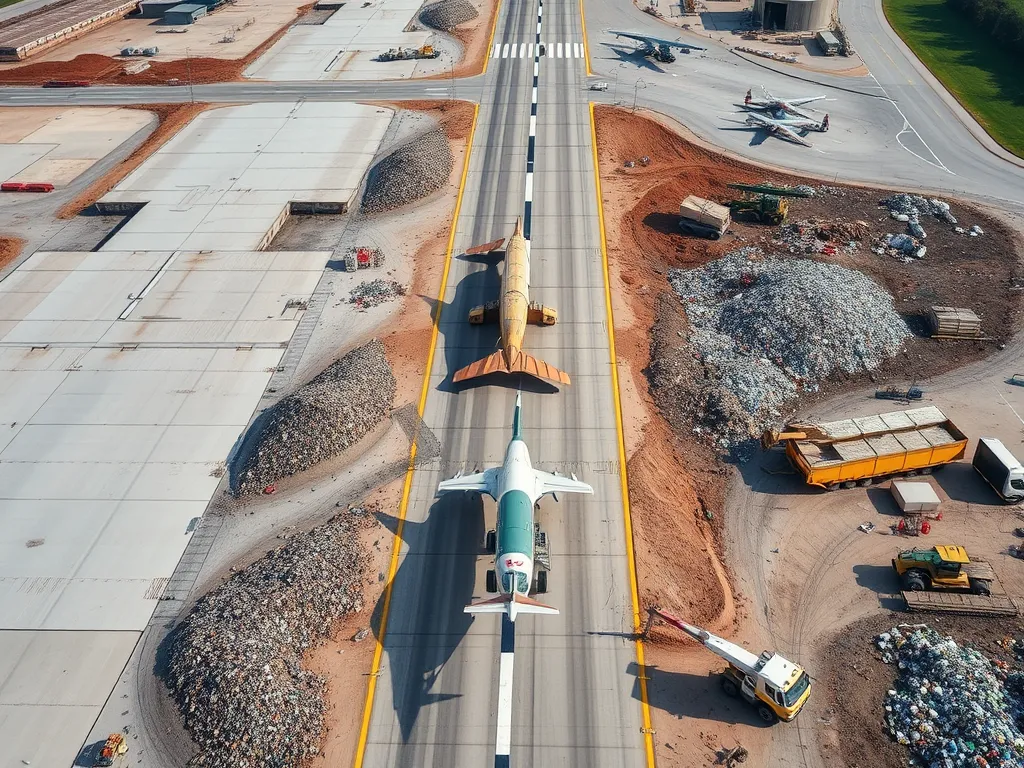Cold Mix Asphalt for Airports: Around-the-clock Repairs Without the Heat
Published on: October 15, 2025 | Last Updated: April 14, 2025
Written By: George Voss
Cold mix asphalt is an unheated paving material combining aggregates with bitumen emulsion—a liquid binder that activates without high temperatures. Airports choose it over hot mix asphalt for urgent fixes on runways, taxiways, and aprons where flight schedules can’t wait. Crews apply it directly from the bag at temps as low as 40°F, achieving initial compaction in 30 minutes and full cure within 2 hours. It handles loads up to 80,000 pounds per wheel and resists jet fuel spills better than standard asphalt.
This guide covers cold mix asphalt’s role in airfield maintenance. We’ll analyze mix designs with granite aggregates and PG 76-22 polymer binders. Explore repair methods for 12-inch-deep potholes versus ¼-inch surface cracks. Compare costs: cold mix runs $45-$65 per ton versus $90-$120 for hot mix. See how Dallas-Fort Worth and Denver International use it for overnight taxiway repairs without delaying morning flights.
Contents
- Understanding Cold Mix Asphalt
- Applications in Airport Infrastructure
- Suitability for Airfield Pavements
- Airport-specific Asphalt Mixes
- Performance Advantages and Limitations
- Application Techniques for Airfields
- Cost Analysis for Airport Projects
- Environmental Factors in Airfield Paving
- FAQs About Cold Mix Asphalt for Airports
- Closing Thoughts
- Additional Resources for You:
Understanding Cold Mix Asphalt
What is Cold Mix Asphalt?
Cold mix asphalt serves as a ready-to-use paving material that requires zero heating during production or application. Airports use specialized cold mixes containing liquid asphalt binders (like emulsified bitumen or cutback asphalt) mixed with aggregates at ambient temperatures. This allows year-round repairs even in freezing conditions – critical for maintaining 24/7 airfield operations.
Core Components Of Airfield Asphalt Mixes
Airfield cold mix asphalt blends three key elements engineered for aviation demands:
- Aggregates: 3/8″ crushed granite or limestone meeting FAA AC 150/5370-10G specs. Angular particles boost interlock strength
- Binders: High-float emulsified asphalt (HFMS-2s) or PG 76-28 polymer-modified bitumen for jet fuel resistance
- Additives: Cellulose fibers (0.3% by weight) or crumb rubber (5-15%) to prevent raveling under thrust reversers
Gradation curves follow FAA P-401 specifications, with 95% passing the ½” sieve and 2-6% binder content based on traffic levels. Tested Marshall Stability values exceed 1,500 lbf for taxiway patches.
With these components defined, let’s examine how cold mix performs in critical airfield applications.
Applications in Airport Infrastructure
Airports rely on cold mix asphalt for critical surfaces facing constant stress from aircraft loads and weather shifts. This material’s versatility shines across three key zones where traditional hot mix methods falter under tight deadlines or extreme conditions.
Cold Mix Asphalt for Runway Repairs
Runways demand swift fixes to maintain flight schedules. Cold mix asphalt airport pavement solutions allow crews to patch spalls, cracks, or erosion within 2-4 hours of downtime. Specially formulated airfield cold mix asphalt blends polymer-modified PG 64-22 binders with angular aggregates graded to FAA AC 150/5370-10 standards. These repairs withstand Boeing 777 wheel loads exceeding 60,000 pounds at touchdown while resisting jet blast temperatures up to 300°F.
Taxiway Maintenance With Cold Pour Asphalt
Taxiways benefit from cold pour asphalt’s flowable consistency for filling alligator cracks and joint gaps. Airfield cold pour asphalt achieves 95% density without rollers through self-compacting designs. A 2022 study at Chicago O’Hare showed taxiway patches using ASTM D6626-compliant mixes lasted 3-5 years before requiring replacement – matching hot mix performance at 22% lower material costs.
Apron Surfacing Solutions
Aircraft aprons face unique challenges from static loads and fuel spills. Cold mix asphalt airports specify high-stability mixes with 6-8% bitumen content and Trinidad Lake asphalt additives for fuel resistance. These blends maintain flexibility at -20°F, critical for northern hubs like Anchorage International. Recent advances integrate 30% recycled asphalt pavement (RAP) into apron mixes without compromising the 40 kN Marshall Stability required for Airbus A380 operations.
While cold mix asphalt airfield applications solve immediate needs, their long-term performance hinges on proper mix selection and installation protocols. Next, we examine how these materials hold up under sustained air traffic demands.

Suitability for Airfield Pavements
Cold mix asphalt for airports must meet strict airfield needs. It works where hot mix can’t, but has key limits to know.
What Type Of Asphalt is Used for Runways?
Most runways use hot mix for long life. But cold mix steps in for fast fixes. Airfield cold mix blends sharp stone, tough bitumen, and special glue-like agents. These parts let it set hard without heat. Mixes made for airfields often have 3/4″ stone for strong grip under plane tires.
Load-bearing Capacity for Aircraft Traffic
A Boeing 747 can weigh 800,000 pounds. Cold mix for airfields holds up by using 90-100% crushed stone. Proper pack with 10-ton rollers hits 95% density. Some mixes add fibers to spread weight wide. This lets them take 250+ psi loads – enough for most taxiway patches.
Temperature Tolerance in Airport Operations
Places like Phoenix hit 120°F, while Alaska sees -20°F. Cold mix for airport jobs uses PG 64-34 bitumen. This grade stays firm in heat but bends in cold. Tests show less than 0.1″ rut after 10,000 load cycles at 140°F. Winter mixes add more oil to stop cracks when temps swing fast.
Airport teams pick cold mix when time or weather blocks hot work. Next, we’ll break down how these mixes are made just for airfield use.
Also See: Asphalt Type Selection Guide: Choosing the Right One
Airport-specific Asphalt Mixes
Airfield operations demand specialized paving solutions. Standard cold mix formulas often fall short under jet thrust or extreme loads. Enter engineered asphalt blends meeting FAA Advisory Circular 150/5370-10 specs.
What is Airport Mix Asphalt?
Airport mix asphalt refers to cold-applied formulas optimized for aviation environments. These blends combine high-grade aggregates (crushed granite or basalt) with modified binders like PG 76-22. Unlike standard road mixes, they contain additives to resist jet fuel degradation and hydraulic erosion from stormwater runoff. Typical compositions include 6% binder content with 20-30% recycled asphalt pavement (RAP).
Customized Formulations for Airfield Demands
Three critical factors shape cold mix designs for airports:
- Load ratings: Mixes must support 400,000+ lb aircraft loads through enhanced aggregate interlock
- Surface friction: Aggregate PSV values ≥60 prevent skid risks during wet landings
- Deformation resistance: Polymer-modified binders maintain stability from -40°F to 140°F
Advanced variants incorporate latex modifiers or carbon fiber strands for blast pad areas exposed to 600°F exhaust temps. Some airfields now use Superpave-designed cold mixes achieving 98% density with 8-ton rollers.
With performance parameters established, let’s examine how these engineered mixes handle real-world operational stresses.

Performance Advantages and Limitations
Airport maintenance crews face unique challenges when selecting pavement materials. Cold mix asphalt for airport repairs offers distinct benefits but requires careful evaluation against operational demands.
Benefits Of Cold Mix for Airport Patching
Cold mix asphalt airport pavement solutions excel in time-sensitive scenarios. Unlike hot mix requiring 275-325°F production temperatures, cold mix uses emulsified binders that cure at ambient temperatures.
Rapid Cure Times for Minimized Downtime
Airfield cold mix asphalt achieves traffic-ready surfaces in 2-4 hours versus 24+ hours for traditional mixes. This allows airports like Denver International to complete taxiway patching during brief 3-hour flight gaps. FAA AC 150/5370-10G permits immediate reopening for light aircraft under 12,500 lbs.
What Are the Disadvantages Of Cold Mix Asphalt?
While ideal for temporary fixes, cold mix for asphalt airports has limitations in permanent airfield applications. The lower compaction density (92-95% vs 96-98% for hot mix) impacts long-term performance under heavy loads.
Durability Considerations for Heavy Traffic
Boeing 777-300ER aircraft exert 86 PSI tire pressures – near the 90 PSI limit for most airfield cold pour asphalt. Repeated jet blast exposure above 300°F can soften emulsified binders, requiring more frequent reapplications in high-traffic zones.
| Metric | Cold Mix | Hot Mix |
|---|---|---|
| Compressive Strength | 1,200-1,800 PSI | 3,000-4,000 PSI |
| Service Life (Taxiways) | 6-18 months | 5-8 years |
| Material Cost/Ton | $45-65 | $80-120 |
Proper installation methods can maximize cold mix asphalt airports’ potential. Let’s examine specialized application techniques that address these performance gaps.
Application Techniques for Airfields
Proper installation methods determine success with cold mix asphalt for airport pavement. Airfield crews need specialized approaches to meet strict Federal Aviation Administration (FAA) AC 150/5370-10 standards while maintaining operational readiness.
Cold Resurfacing Methods
Spray-injection patching systems dominate runway repairs using airfield cold mix asphalt. These truck-mounted units blast debris from potholes at 120 PSI, apply tack coat, and fill voids with polymer-modified mixes containing 20-30% RAP (Recycled Asphalt Pavement). For large-scale work, spreaders lay windrow stockpiles at 3-4 inch lifts without heating – critical near fuel zones where hot mix poses fire risks.
Chip Seal Integration
Airfield asphalt paving teams combine cold pour asphalt with chip seals for surface renewal. A 0.25-0.35 gal/sy CRS-2P emulsion base gets topped with 3/8″ granite chips, creating skid-resistant textures that handle 300°F jet exhaust. This hybrid approach extends pavement life 7-10 years at 40% less cost than full-depth replacement, per FAA Advisory Circular 150/5380-6B guidelines.
Compaction Requirements for Airport Pavements
Steel-drum vibratory rollers achieve 92-95% density with cold mix asphalt airfield applications – non-negotiable for taxiways bearing Airbus A380 loads. Operators make 8-12 passes at 3-5 mph, monitoring with nuclear density gauges. Night work exploits cooler temps for better particle alignment, crucial when restoring 12″ thick aprons between cargo flights.
Mastering these techniques prepares teams to evaluate cost impacts – a key factor we’ll explore next.

Cost Analysis for Airport Projects
Airport teams weigh cost when picking cold mix or hot mix. Cold mix asphalt for airports cuts first costs but needs smart long-term plans.
Price Comparison: Cold Mix Vs Hot Mix Asphalt
Cold mix asphalt airport jobs cost $45-$75 per ton. Hot mix runs $80-$120 per ton. Cold pour needs no heat, which saves fuel costs. See key price gaps:
| Factor | Cold Mix | Hot Mix |
|---|---|---|
| Material Cost | $45-$75/ton | $80-$120/ton |
| Plant Fuel Use | None | 150-200°F heating |
| RAP Use | Up to 100% | Max 30% |
RAP (recycled old pavement) in cold mix cuts costs by 15-20%. PG binders (performance-graded asphalt) add $5-$8 per ton but boost strength.
Long-term Maintenance Cost Considerations
Cold mix asphalt airfield repairs may need more fixes than hot mix. But each cold patch costs 60% less. FAA studies show cold mix saves 30-40% over 10 years for taxiways and aprons.
Key cost factors:
– Life span: Hot mix lasts 8-12 years vs 3-5 for cold mix – Labor: Cold jobs need 50% less crew time – Gear: No pavers or rollers for small cold patches
Airport teams must weigh both cost and green factors. Next, we look at how cold mix cuts energy use and works with recycled stuff.
Environmental Factors in Airfield Paving
Airport projects face strict environmental targets. Cold mix asphalt for airports meets these demands through reduced energy use and material recycling capabilities. Two factors drive its eco-profile: production methods and recycled content handling.
Energy Efficiency in Production
Traditional hot mix asphalt requires heating to 300°F-350°F. Cold mix airport pavement skips high-temperature processing. Mixing occurs at ambient temperatures (50°F-80°F), cutting fuel use by 60% per ton. This slashes greenhouse gas emissions by 35%-50% compared to hot mix methods.
- No burner fuels needed for aggregate drying
- Lower CO2 output: 18-22 kg/ton vs 40-45 kg/ton for hot mix
- UL ECOLOGO® certified mixes available for LEED projects
Airports using cold mix for airfield repairs report 28%-42% lower energy costs per square yard. The FAA’s Airport Improvement Program prioritizes such reductions under AC 150/5370-10 standards.
Recycled Material Compatibility
Cold mix asphalt airport pavement accepts up to 40% reclaimed asphalt pavement (RAP) without performance loss. Specialized emulsifiers bind aged and new materials effectively. Some airfield cold pour asphalt blends incorporate 5% recycled asphalt shingles (RAS) for enhanced durability.
- FAA-approved RAP gradations: 1/2″ max aggregate size
- 15%-20% material cost savings vs virgin mixes
- UL 3601 certification for circular material flows
Dallas/Fort Worth Airport’s 2023 taxiway project used 32% RAP in cold mix, diverting 1,800 tons from landfills. The blend met FAA P-401 specs for stability (1,800-lb minimum Marshall value) while cutting costs by $19/ton.
With energy and recycling advantages proven, airport engineers next evaluate operational factors. Common questions arise about cure rates, load limits, and long-term performance under jet traffic.

FAQs About Cold Mix Asphalt for Airports
What is Cold Mix Asphalt Used for in Airports?
Cold mix asphalt is primarily used for urgent repairs on runways, taxiways, and aprons where immediate operational readiness is crucial. Its ability to be applied in various weather conditions makes it ideal for maintaining airfield surfaces swiftly without the need for heating.
How Does Airport Mix Differ From Standard Asphalt?
Airport mix asphalt is specially formulated to meet the demanding requirements of aviation environments. It features high-grade aggregates and modified binders to enhance resistance to jet fuel and withstand heavy aircraft loads, unlike standard asphalt mixes intended for roads.
Can Cold Mix Withstand Jet Engine Blast Effects?
Yes, cold mix asphalt is designed to withstand the high temperatures and powerful forces generated by jet engine blasts. With specific formulations that include polymer-modified and high-stability aggregates, it can resist the erosive effects of jet blasts, maintaining the integrity of the airfield surface.
What Determines Mix Selection for Runway Projects?
The selection of a cold mix for runway projects depends on several factors, including the anticipated aircraft load, environmental conditions, curing time, and specific performance requirements set by FAA guidelines. Engineers consider these variables to ensure the right asphalt mix is chosen for durability and safety.
Closing Thoughts
Cold mix asphalt plays a vital role in airport maintenance. Its quick application and ability to minimize downtime make it a preferred choice for runway repairs, taxiway maintenance, and apron surfacing. Understanding the unique demands of airfield pavements ensures that airports can effectively utilize this material.
While cold mix asphalt offers advantages like rapid curing and cost savings, it’s important to weigh these benefits against its durability for heavy aircraft traffic. Customized formulations can enhance performance, making cold mix a versatile option when applied correctly.
For further insights on cold mix asphalt and its applications in airport projects, visit Asphalt Calculator USA. Our site provides resources to help you make informed decisions about asphalt choices for your specific needs.


